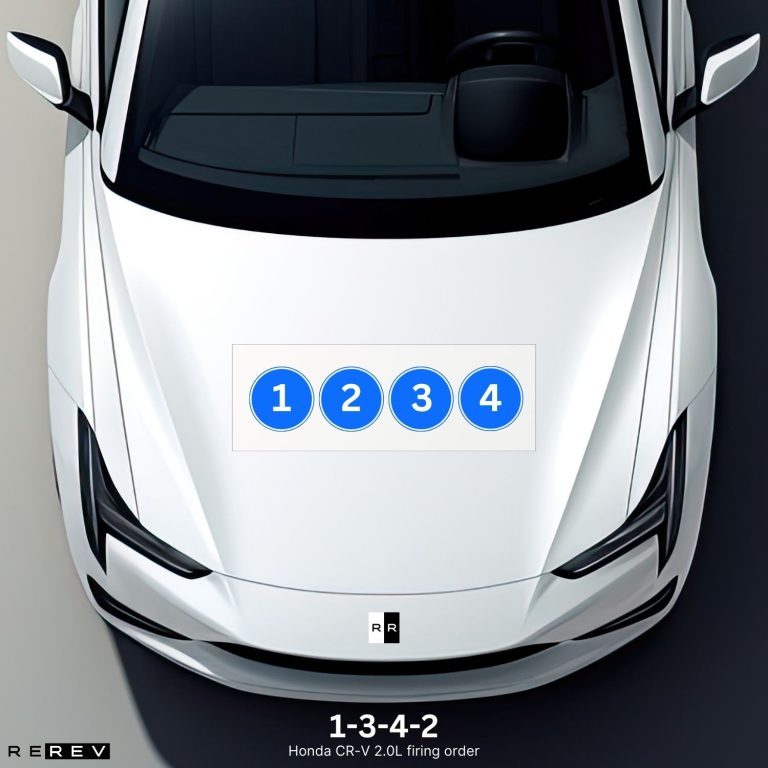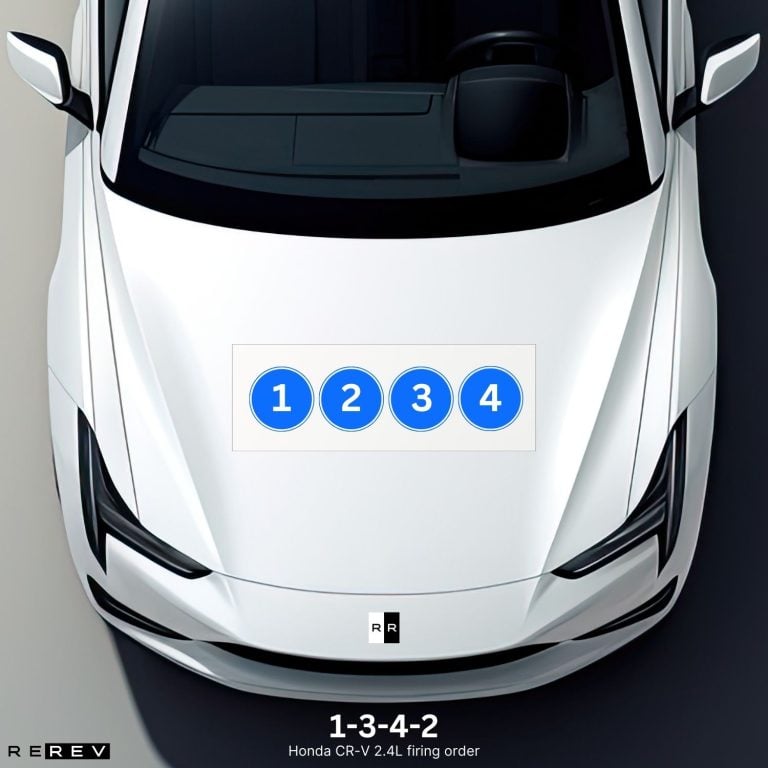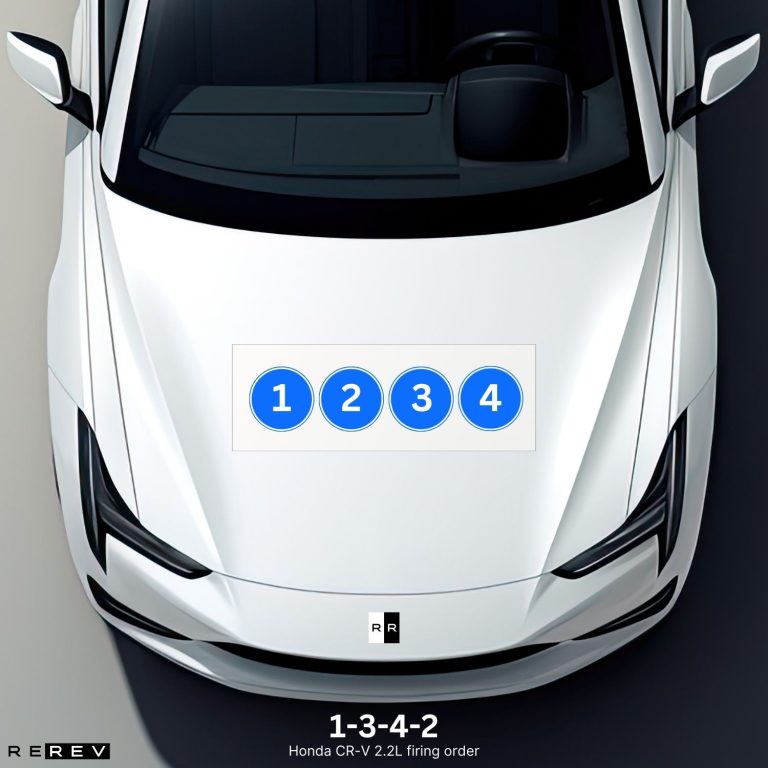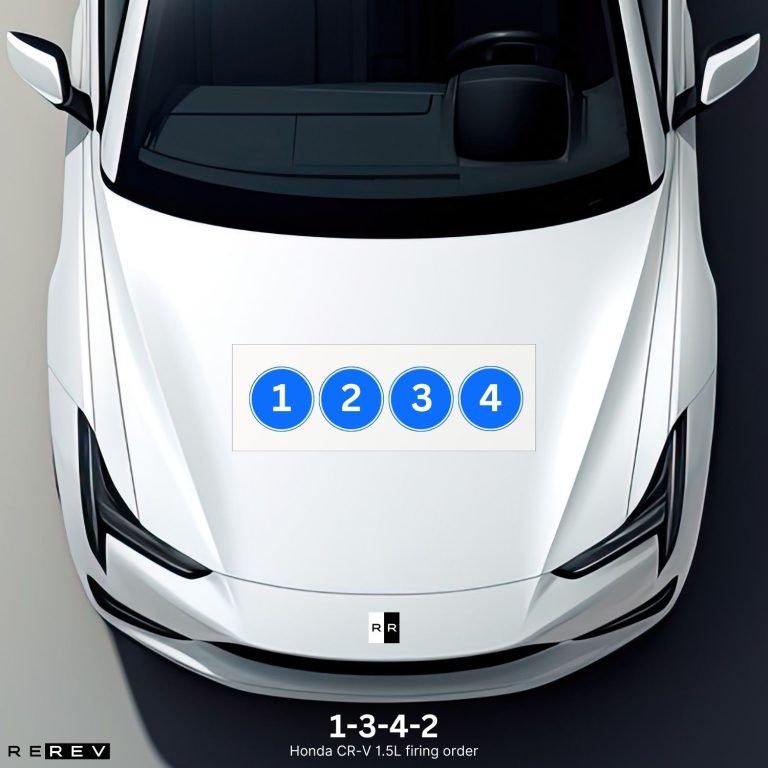Honda CR—V (1995-2023) firing order — diagram & guide

The CR-V has been one of the most popular Honda SUV models in the past two decades and one of the most beneficial things about this model is the variety of engines offered. From four-cylinder VTEC engines to turbocharged and diesel options, almost all of them make a good choice in terms of reliability.
The thing is – some of these require more frequent maintenance than others and this guide on Honda CR-V (1995-2023) firing order will help you with that. Whether you are dealing with misfires, or simply wish to check the engine’s plugs and coils, our team will provide you with the necessary engine specs so you can do it seamlessly.
| CR-V YEARS | ENGINE | FIRING ORDER |
|---|---|---|
| 1st Gen (1995-2000) | 2.0L | 1-3-4-2 |
| 2nd Gen (2001-2005) | 2.0L | 1-3-4-2 |
| 2.4L VTEC | 1-3-4-2 | |
| 2.2L diesel | 1-3-4-2 | |
| 3rd Gen (2006-2010) | 2.0L | 1-3-4-2 |
| 2.4L VTEC | 1-3-4-2 | |
| 2.2L diesel | 1-3-4-2 | |
| 4th Gen (2011-2015) | 2.0L | 1-3-4-2 |
| 2.4L | 1-3-4-2 | |
| 2.2L diesel | 1-3-4-2 | |
| 5th Gen (2016-2021) | 1.5L turbo | 1-3-4-2 |
| 2.0L | 1-3-4-2 | |
| 2.4L | 1-3-4-2 | |
| 6th Gen (2022-present) | 1.5L turbo | 1-3-4-2 |
| 2.0L | 1-3-4-2 |
First-generation Honda CR-V (1995-2000) firing order
The first-gen Honda CR-V had several engine options offered and the convenient thing for drivers is that they all had the same firing order. It’s mostly due to Honda using four-cylinder engines with a common firing pattern, so that makes your job a bit easier.
We’ll still go through each engine individually so you can get a sense of cylinder locations and their firing positions.
Honda CR-V 2.0L firing order

Honda’s 2.0-liter engine has been the base of CR-V engines for years and it first appeared with the first-gen SUV mode. The Honda CR-V firing order is 1-3-4-2 and the cylinders of this engine are aligned from left to right.
So, if you pop the hood open and obverse the engine from a mechanic’s perspective, the first cylinder will be the furthest one to the left. Cylinders 2, 3, and 4 follow up to the right side of the engine, so it’s easy to identify the cylinder positions for this particular engine.
Second-generation Honda CR-V (2001-2005) firing order
As the base option for the second-gen Honda CR-V model, the brand still kept the 2.0-liter engine. However, there’s the addition of a VTEC-powered 2.4-liter engine with a higher redline and power output, and Honda’s first diesel engine in the later model years of the second generation.
Since we’ve already discussed the 2.0L engine, we’ll focus our attention to the latter two options and their firing orders.
Honda CR-V 2.4L firing order

The 2.4-liter came as an option during the production of the second-gen CR-V and this engine was still a four-cylinder one. That’s why it’s no wonder that the Honda CR-V 2.4L firing order is 1-3-4-2 since it’s a common firing pattern for all the Honda’s four-cylinders of that time.
Plus, the cylinder arrangement in this case matches the one of the 2.0L engine since the first cylinder is still on the left side, with the fourth cylinder being on the right.
Honda CR-V 2.2L firing order

While the diesel engine slightly differed from the petrol options, the Honda CR-V 2.2L firing order is 1-3-4-2 as well. Moreover, the engine’s configuration was still the same as the cylinders were laid out from the first one on the left side to the fourth one on the right side.
The differences were mostly in the way the combustion is achieved since the diesel engine doesn’t have all the inner components like the petrol one. So, cylinder misfires and spark plug issues are rare on these as the diesel used glow plugs instead, but using the firing order still helps prevent stalling.
Third-generation Honda CR-V (2006-2010) firing order
The third-gen Honda CR-V firing order is 1-3-4-2 for all the engines offered since there were no new engine options added for this generation. Once again, drivers could find common engines like the 2.0L four-cylinder, 2.4L VTEC, and the 2.2-liter diesel one, so things were more or less the same as for the previous generation in terms of the firing order.
Fourth-generation Honda CR-V (2011-2015) firing order
Honda didn’t want to change anything without the need for the fourth-gen model of the CR-V since all the same engine options were still used for this one. Just like for the two previous generation models, drivers could choose between the two petrol options and a diesel engine, so we’ll move on to the next generation.
Fifth-generation Honda CR-V (2016-2021) firing order
Changes were finally made for the Honda CR-V in its fifth-gen model since the 2.2-liter diesel engine wasn’t offered any longer. Instead, we had a 1.5-liter turbo petrol engine along with the already mentioned 2.0L and 2.4L VTEC engines.
Honda CR-V 1.5L firing order

The Honda CR-V 1.5L firing order is 1-3-4-2 which is once again the common pattern of CR-V engine options. Once again, the engine’s cylinders were arranged from the left to the right side of the engine, in straight order from 1 to 4.
It’s important to note the specific cylinder order since some other Honda models use the 1.5L turbo engine in a different layout from the front end of the engine to the rear.
Sixth-generation Honda CR-V (2022-present) firing order
The sixth-gen of the Honda CR-V is still in production and this one has the standard 1-3-4-2 firing order. Just like with the previous generations of the CR-V, the cylinder layout is from number one on the left side to number four on the right side for both the 1.5L and the 2.0L engine options.
Our take
Overall, the CR-V is a reliable SUV model in the mid-size class and four-cylinder engines were more than enough to get the wheels rolling even with extra cargo. That’s a convenient thing for you as a driver since all the engine options come with the same 1-3-4-2 firing order, so it’s easier to apply it in your DIY maintenance.